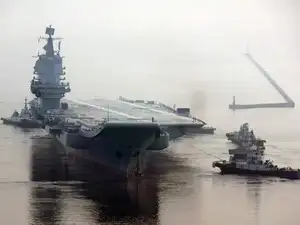While China’s growing naval fleet is grabbing headlines across the world, a critical weakness remains hidden beneath the decks of its aircraft carriers — a severe shortage of carrier-qualified fighter pilots. At the heart of this gap is the J-15 Flying Shark, China’s primary carrier-based fighter jet, which now finds itself without enough trained aviators to make it battle-ready, reported Economic Times .
This shortfall raises serious questions about the actual combat readiness of the People’s Liberation Army Navy (PLAN), especially as China aspires to project naval power well beyond its shores.
Flying Sharks Without Fins?
On paper, China’s naval aviation appears formidable. With three aircraft carriers — the Liaoning, the Shandong, and the newly launched Fujian — and more reportedly under construction, the country has built one of the largest carrier programs outside the United States.
The J-15, modeled loosely on Russia’s Su-33, is meant to be the pride of China’s carrier operations. But despite having over 50 J-15s produced, experts estimate that China has fewer than 200 fully trained, carrier-capable fighter pilots — barely enough to keep its growing fleet operational.
No Seaborne Jet Trainers, No Time to Train
Unlike the U.S. Navy, which uses dedicated aircraft like the T-45 Goshawk to train its naval aviators for carrier landings, China lacks a similarly capable seaborne jet training system. This means that Chinese pilots must learn the grueling art of carrier landings using the J-15 itself — a much riskier and more expensive process.
The result: delayed pilot induction, extended training cycles, and a high failure rate in achieving carrier qualification.
Experts believe this training gap is not just a logistical problem, but a major strategic bottleneck that threatens China’s plans for long-range naval projection.
Why Carrier Aviation Is So Demanding
Operating a jet off a carrier is one of the most complex tasks in military aviation. Pilots must learn to take off from short ski-jump ramps, land with pinpoint accuracy on narrow flight decks, and often operate in high-sea states or combat scenarios.
Each carrier-capable pilot typically undergoes years of ground-based simulator training, followed by intensive land-based flight instruction, and finally, actual carrier-deck certification. Without the right training aircraft or infrastructure, this becomes a slow, dangerous, and resource-intensive process.
The Real Risk: Hollow Naval Power
While China’s carrier fleet may look impressive during parades and drills, the lack of skilled aviators means many J-15s may never take off in real combat situations. It’s a case of having the sword but no one trained to swing it.
Military analysts warn that this gap could delay China’s ambitions to project power in the Indo-Pacific, especially at a time when tensions in the Taiwan Strait and South China Sea continue to simmer.
Moreover, the training bottleneck might force China to either slow down its carrier operations or rush undertrained pilots into service, both of which come with serious operational and reputational risks.
What’s Next for China’s Naval Aviation?
To address the issue, China is reportedly working on developing its own jet trainer specifically for carrier operations, but such platforms could still take years to reach deployment. Meanwhile, efforts to boost simulation-based training and increase J-15 production continue.
There is also speculation that China might expand joint training programs with Russia or even use land-based airfields with simulated carrier decks to speed up pilot induction.
But until these efforts yield results, China’s powerful new carriers may continue to sail with empty cockpits — a quiet vulnerability in an otherwise roaring military expansion.
Photo Credit: Getty Images




